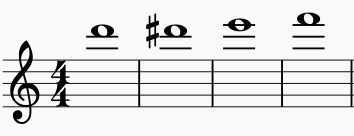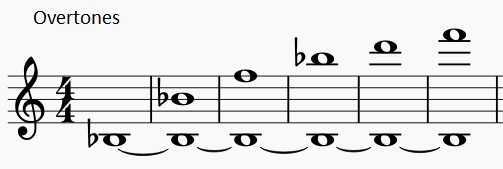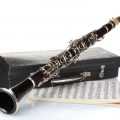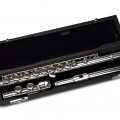What are “warm-ups”? “Warm-ups” are simple exercises that you perform in order to prepare yourself for more complex activities. We can think of warming up in a few different contexts. Athletes, runners, and weightlifters may warm up by jogging, stretching, or lifting light weights. The purpose of doing this is to get the blood flowing, to avoid injury, and to increase performance. Actors, radio personalities, and news anchors may warm up by performing vocal exercises or tongue twisters in order to increase articulation and avoid potential stuttering. Musicians benefit greatly from warming up as well. Warming up can help musicians avoid stress and injury, as well as help them achieve peak performance. The point of warming up, in the context of being a musician, is to get your brain and fingers in alignment (mind/body connection), as well as to simply to make you feel as comfortable as possible when performing.

Warm-ups for musicians are highly personal and specific to each individual and each situation. No one knows your playing as well as you do. Your warm-up routine should constantly be evolving. Your warm-ups ten years from now should not be the same as they are now, although there may be certain similarities.
The amount of time it takes to adequately warm up varies dependent on a few factors. Part of warming up is literally warming up. If it’s cold outside, it takes more time to warm up than if it’s hot outside. When I went for my graduate school audition in Ohio, it was freezing outside; the dead of winter in Northwest Ohio. The first few minutes of that specific warm-up consisted of running my hands under warm water. The amount of time warming up takes could also be dependent upon your playing schedule. If you have a very active performing schedule, it could take very little time to adequately warm up. On Saturdays, I usually practice for a few hours in the morning and then play a four hour gig later in the evening. Come Sunday morning church service, I’m adequately warmed up from the night before. Conversely, if you just got back from a two week vacation where you didn’t play your horn at all, it may take a few hours to feel warmed up.
Your warm-up routine also depends on the particular situation and circumstances. There are general warm-ups and there are specific warm-ups. General warm-ups consist of exercises you do to get ready for a long practice session or performance. These are exercises you should do on a daily basis. Specific warm-ups are specific to a given situation. Specific warm-ups could be for an audition or a high pressure performance. These could consist of running specific difficult passages or other material pertinent to the situation.
Saxophone Warm-Ups
It would be impossible to go over all of the possibilities for saxophone warm-ups. For the purpose of this article, I will go over a few of the general ways you can warm up, as sort of template for you to plan your own warm-up routine.
There are some warm-up staples; saxophone warm-ups that every saxophone player does regardless of his or her skill level. Long tones help warm up the instrument as well as strengthen your embouchure. Technical exercises help achieve fluidity, comfort, and control.
Long Tones
The first thing you want to do when beginning your saxophone warm-ups is to literally warm up the horn. A cold saxophone does not sound pleasant. The intonation is flat and inconsistent throughout the range of the horn.
Long tones should be performed as an essential part of your daily warm-up routine. Long tones help warm up the instrument and, long-term, they help to strengthen your embouchure. You want to start in the middle register of the saxophone. You want to do this because the notes in the middle register (G to G) are the easiest to play and they put the least amount of exertion on the reed. To benefit the most from long tones, you want to pay attention to what you’re doing. If you’re not paying attention, if you’re just “phoning it in”, your instrument will get warm, but you won’t get the maximum benefit that long tones have to offer. When playing long tones, you want to listen for intonation and for a steady tone. Ideally, you would play your long tones with a tuner, so you make sure you’re playing in tune throughout the entire range of the horn. You want the tone to be straight, steady, and un-wavering. If you can’t keep a steady tone, that’s okay. It will just take some practice. But, a steady tone is the ultimate goal. You should set your metronome to quarter note = 60 and try to hold each tone for about ten beats.

Once you’ve successfully played your long tones in the middle register, you should move on to the extremes of the horn. The low end and high end of the horn are the most finicky. They tend to be naturally sharp. An added benefit is that this exercises also checks for if repairs are needed (if low notes don’t speak easily).


Another good warm-up is doing overtone exercises. Playing overtone exercises makes the tone of the saxophone sound as full as possible.

Technical Exercises
If long tones are the metaphorical stretching of saxophone warm-ups, then technical exercises are the calisthenics. The whole point of warming up on the saxophone is to ease into playing so that you avoid stress, strain, and potential injury. The basic idea is to go from simple to complex. Think about a weight lifter. A weight lifter is not going to deadlift his or her maximum weight immediately. He or she is going to lift a hundred pounds, then take a break, then lift two hundred, then take a break, etc. That’s why we begin our saxophone warm-ups routine with long tones. We want to keep this ‘simple to complex’ idea in mind when transitioning into technical exercises. You’re not going to go straight into playing your most complex technical exercise at the fastest tempo possible. Forget about injuring yourself. You probably won’t even be able to do it. By easing into more complex exercises, you will have a better chance of ultimately being successful with your more complex material.
Examples of technical saxophone warm-ups can include playing through scales, arpeggios, intervals, etc. I’ve written out a few basic exercises that can serve as potential saxophone warm-ups. Once again, these are just examples. They can give you an idea of exercises to utilize in your warm-up routine. As mentioned above, what you use specifically depends on your individual needs.


You can warm up with major scales and major arpeggios, full length of the horn.


In addition to diatonic exercises, you can warm up with chromatic exercises. Chromatic exercises will make sure every note is working properly, and that there are no pads sticking, etc.


Combining the first two ideas, you can also warm up using diatonic exercises in chromatic intervals.
All of the above exercises should utilize the full length of the horn. You should listen for accuracy, consistency of tone, and consistency of intonation.


In addition to warming up your fingers, you also need to warm up your tongue. These exercises can be used to warm up your tonguing.
Conclusion
 Is warming up necessary? I suppose it’s not completely necessary, but warming up is highly encouraged. Warm-ups decrease the chance of injury, while increasing your chances of success. Who do you think would be more successful: the person who chooses to run a marathon after sitting on their couch watching TV for two weeks, or the person who took an hour out of each day for two week to run a few miles? Warming up may feel like a waste of time sometimes. You want to get to the main material immediately. But, warming up is good for you and ultimately ends up saving more time than it wastes.
Is warming up necessary? I suppose it’s not completely necessary, but warming up is highly encouraged. Warm-ups decrease the chance of injury, while increasing your chances of success. Who do you think would be more successful: the person who chooses to run a marathon after sitting on their couch watching TV for two weeks, or the person who took an hour out of each day for two week to run a few miles? Warming up may feel like a waste of time sometimes. You want to get to the main material immediately. But, warming up is good for you and ultimately ends up saving more time than it wastes.
Musicians should always warm up before long practice sessions and before any performance in order to reach their fullest potential. In addition, warming up the saxophone makes the horn sound the best that it can. Saxophone warm-ups are an essential part of playing the saxophone.







